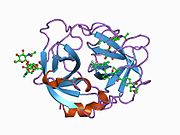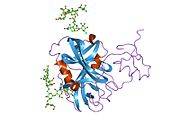Biology:Neutrophil elastase
 Generic protein structure example |
Neutrophil elastase (EC 3.4.21.37, leukocyte elastase, ELANE, ELA2, elastase 2, neutrophil, elaszym, serine elastase, subtype human leukocyte elastase (HLE)) is a serine proteinase in the same family as chymotrypsin and has broad substrate specificity. Neutrophil elastase is secreted by neutrophils during inflammation, and destroys bacteria and host tissue.[1] It also localizes to neutrophil extracellular traps (NETs), via its high affinity for DNA, an unusual property for serine proteases.[2]
As with other serine proteinases it contains a charge relay system composed of the catalytic triad of histidine, aspartate, and serine residues that are dispersed throughout the primary sequence of the polypeptide but that are brought together in the three dimensional conformation of the folded protein. The gene encoding neutrophil elastase, ELA2, consists of five exons. Neutrophil elastase is closely related to other cytotoxic immune serine proteases, such as the granzymes and cathepsin G. It is more distantly related to the digestive CELA1.[2]
The neutrophil form of elastase (EC 3.4.21.37) is 218 amino acids long, with two asparagine-linked carbohydrate chains (see glycosylation). It is present in azurophil granules in the neutrophil cytoplasm. There appear to be two forms of neutrophil elastase, termed IIa and IIb.
Gene
In humans, neutrophil elastase is encoded by the ELANE gene, which resides on chromosome 11.[3]
Function
Elastases form a subfamily of serine proteases that hydrolyze many proteins in addition to elastin. Humans have six elastase genes that encode the structurally similar proteins elastase 1, 2, 2A, 2B, 3A, and 3B. Neutrophil elastase hydrolyzes proteins within specialized neutrophil lysosomes, called azurophil granules, as well as proteins of the extracellular matrix following the protein's release from activated neutrophils. Neutrophil elastase may play a role in degenerative and inflammatory diseases by its proteolysis of collagen-IV and elastin of the extracellular matrix. This protein degrades the outer membrane protein A (OmpA) of E. coli as well as the virulence factors of such bacteria as Shigella, Salmonella and Yersinia.[4] Mutations in this gene are associated with cyclic neutropenia (CyN) and severe congenital neutropenia (SCN). At least 95 disease-causing mutations in this gene have been discovered.[5] This gene is clustered with other serine protease gene family members, azurocidin 1 and proteinase 3 genes, at chromosome 19pter. All 3 genes are expressed coordinately and their protein products are packaged together into azurophil granules during neutrophil differentiation.[6]
Clinical significance
Neutrophil elastase is an important protease enzyme that when expressed aberrantly can cause emphysema or emphysematous changes. This involves breakdown of the lung structure and increased airspaces. Mutations of the ELANE gene cause cyclic and severe congenital neutropenia, which is a failure of neutrophils to mature.[7] In 2019 study was confirmed that ELANE deletion does not cause neutropenia.[8]
Inhibitors
In order to minimize damage to tissues, there are few inhibitors of neutrophil elastase. One group of inhibitors are the Serpins (Serine Protease Inhibitors).[9] Neutrophil elastase has been shown to interact with Alpha 2-antiplasmin, which belongs to the Serpin family of proteins.[10][11]
See also
References
- ↑ "Degradation of outer membrane protein A in Escherichia coli killing by neutrophil elastase". Science 289 (5482): 1185–8. August 2000. doi:10.1126/science.289.5482.1185. PMID 10947984. Bibcode: 2000Sci...289.1185B.
- ↑ 2.0 2.1 "Leukocyte protease binding to nucleic acids promotes nuclear localization and cleavage of nucleic acid binding proteins". J. Immunol. 192 (11): 5390–7. June 2014. doi:10.4049/jimmunol.1303296. PMID 24771851.
- ↑ "Structure of the human neutrophil elastase gene". J. Biol. Chem. 263 (29): 14739–47. October 1988. doi:10.1016/S0021-9258(18)68099-8. PMID 2902087. http://www.jbc.org/cgi/reprint/263/29/14739.
- ↑ "Neutrophil elastase targets virulence factors of enterobacteria". Nature 417 (6884): 91–4. May 2002. doi:10.1038/417091a. PMID 12018205. Bibcode: 2002Natur.417...91W.
- ↑ "Refinement of evolutionary medicine predictions based on clinical evidence for the manifestations of Mendelian diseases". Scientific Reports 9 (1): 18577. December 2019. doi:10.1038/s41598-019-54976-4. PMID 31819097. Bibcode: 2019NatSR...918577S.
- ↑ "Entrez Gene: ELA2 elastase 2, neutrophil". https://www.ncbi.nlm.nih.gov/sites/entrez?Db=gene&Cmd=ShowDetailView&TermToSearch=1991.
- ↑ "The many causes of severe congenital neutropenia". N. Engl. J. Med. 360 (1): 3–5. January 2009. doi:10.1056/NEJMp0806821. PMID 19118300.
- ↑ "ELANE whole gene deletion mutation". Blood Advances 3 (16): 2470–2473. August 2019. doi:10.1182/bloodadvances.2019000498. PMID 31427279.
- ↑ "Neutrophil elastase, proteinase 3, and cathepsin G as therapeutic targets in human diseases". Pharmacol. Rev. 4 (62): 726–59. December 2010. doi:10.1124/pr.110.002733. PMID 21079042.
- ↑ "Proteolytic cleavage and inactivation of alpha 2-plasmin inhibitor and C1 inactivator by human polymorphonuclear leukocyte elastase". J. Biol. Chem. 257 (16): 9849–54. August 1982. doi:10.1016/S0021-9258(18)34149-8. PMID 6980881.
- ↑ "The reactive site of human alpha 2-antiplasmin". J. Biol. Chem. 262 (13): 6055–9. May 1987. doi:10.1016/S0021-9258(18)45536-6. PMID 2437112.
Further reading
- "Clinical implications of mutations of neutrophil elastase in congenital and cyclic neutropenia". J. Pediatr. Hematol. Oncol. 23 (4): 208–10. 2001. doi:10.1097/00043426-200105000-00005. PMID 11846296.
- "Role of neutrophil elastase in bone marrow failure syndromes: molecular genetic revival of the chalone hypothesis". Curr. Opin. Hematol. 10 (1): 49–54. 2003. doi:10.1097/00062752-200301000-00008. PMID 12483111.
- "Neutrophil elastase mutations in congenital neutropenia". Hematology 8 (3): 165–71. 2003. doi:10.1080/1024533031000107497. PMID 12745650.
- "Hereditary neutropenia: dogs explain human neutrophil elastase mutations". Trends Mol Med 10 (4): 163–70. 2004. doi:10.1016/j.molmed.2004.02.002. PMID 15059607.
External links
- GeneReviews/NCBI/NIH/UW entry on ELANE-Related Neutropenias
- Neutrophil+Elastase at the US National Library of Medicine Medical Subject Headings (MeSH)
- Overview of all the structural information available in the PDB for UniProt: P08246 (Neutrophil elastase) at the PDBe-KB.
 |






